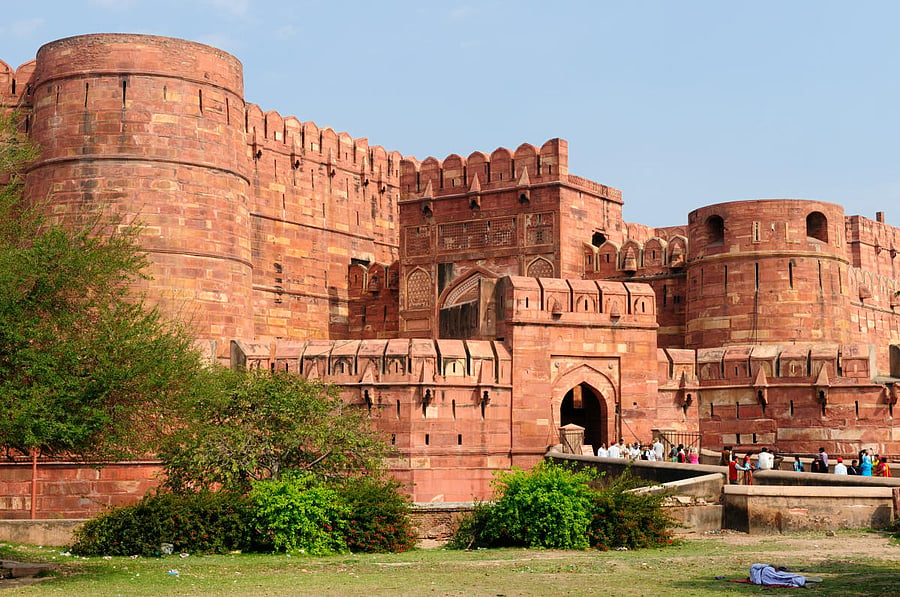
There was a silence in the car, the kind usually reserved for family get-togethers where no one approves of one another. Our driver Rashid though, had launched enthusiastically into the history and geography of the very thing responsible for all that hush — the Agra petha.
Now, it is better to make it clear at the very outset that there are two kinds of people in this world — those who love the Agra petha and those who detest it. My family is in the latter group and I evidently belong to the former. So when I said I will not leave Agra without at least a kilogram of the aforementioned delicacy, I first got aghast looks. Petha?! That sickly-sweet dessert? That shapeless horror fashioned out of gourd! How can you like that? Eww! And then came the stiff, silent acquiescence that did nothing to dent my zeal to bite into one.
So Rashid manoeuvred our car inside the famously narrow gallis of the Agra market in search of the ‘best petha’ in town. It was dusk and the market shops were already winding down. People were few and cows many; in the air, the inevitable smell of the forever small town.
Petha, though, has moved on from its humble roots. Today, Agra’s petha comes in eye-popping varieties — there is the kesar petha, the mithai-pan petha, the dry fruits-studded angoori petha, the flavoursome kewda petha… the list is endless. It is another matter that petha purists like me believe nothing can beat the original, translucent version, its sugar syrup masking the blandness of the ash gourd from which it is prepared while retaining the vegetable’s crunch.
In a sense, petha represents the very city it originates from. Agra too has many flavours and much crunch if only one is able to go past the sugar syrup. The Taj Mahal, of course. So overpowering is the monument to love that it masks all the other pleasures that Agra has to offer. However, we were determined to sample it all.
Ghost city
Our first stop was the ghost city of Fatehpur Sikri. Rather unfortunate that today, it is introduced by local guides as the ‘place where Shah Rukh Khan’s Pardes was shot’ rather than as a great king’s unfulfilled ambition. A World Heritage Site, its Buland Darwaza remains one of the grandest examples of Mughal architecture.
Akbar built the city after Salim’s birth with every intention of shifting his capital here but that was not to be. Some say it was because of a severe water shortage but others believe, once built, Akbar’s desire to live in this spectacle of a city simply faded. Today, it is humongous and hollow; a large, meandering complex of buildings where tourists wander around, often aimlessly, quite in sync with Fatehpur Sikri’s ostensible purposelessness.
A fort full of poetry
Next, we stepped into the Agra Fort and promptly got lost. Stunning in its grandeur and overwhelming in its attention to detail, quite simply, this must be one of the finest forts of the Mughal era. Walk inside its imposing red sandstone gates and immediately you begin to marvel at the scale of imagination that gave rise to this once-military structure. The Mughals could never resist throwing in a bit of poetry and beauty in everything, could they? Never mind that it started out as a fort but soon became a maze of palaces, bathing ghats, darbar halls, manicured gardens and underground passages — a city within a city.
What was meant to be a buffer for war gradually became yet another ode to love and poetry. It takes a while to drink in how casually some truly exquisite marble inlay work is scattered around this so-called fortress. Look and you will discover Shah Jahan’s sensibilities weaved into every other brick and stone despite the fact that the fort was originally constructed by Akbar and was only later improved upon by his successors. Mussaman Burj, an enclosure inside the fort, was where the architect-king spent his final days — this was his prison and perhaps his jannat too. From its ramparts, he was allowed to glimpse the Taj; on clear days, the sheer white of its dome must have sparkled like love itself for him. On gloomier days, like the one we visited the fort on, the Taj was merely an imagined splendour in the haze.
One of the fort’s crowning glories is the Diwan-i-Aam, which housed the infamous peacock throne (inlaid with the Kohinoor). But the more opulent one is the Diwan-i-Khas with its not-an-inch spared marble inlay work on arches and columns.
Among the many buildings housed inside the fort, arguably the most striking is the Khas Mahal that was built by Shah Jahan for his daughters Jahanara and Roshanara.
Near-magical in its architectural ability to represent power and light (essentially the meanings of his daughters’ names), the Khas Mahal is indeed khas (special) as its name suggests.
Built entirely in marble and originally painted and gilded in gold, the palace stands today as a forlorn testimony to this accidental emperor’s carefully-honed aesthetic sense. Time has dried up its rainbow fountains and no water shimmers through its canal niches. And yet, here, in this palace of doomed dreams, light flows like water.
By the time we managed to step out of the maze that is Agra Fort, daylight was fast waning. And as the Yamuna curved herself around the golden sunset, there was time to see only one last thing before we left this city to revel in its many moods.
So we saw the Taj.